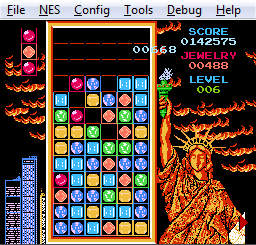Magic Jewelry
| Magic Jewelry | |
|---|---|
 Game screenshot on the FCEUX emulator. | |
| Developer(s) | Hwang Shinwei |
| Publisher(s) | RCM Group |
| Platform(s) | NES |
| Release | 1990 |
| Genre(s) | Puzzle |
| Mode(s) | Single-player |
Magic Jewelry (Chinese: 魔法寶石; pinyin: Mófǎ Bǎoshí; literally: "Magic Gems"), is an unlicensed Nintendo NES tile-matching puzzle video game derivative to Columns, programmed in Taiwan by Hwang Shinwei and published by RCM in 1990.[1]
This title is common on pirate Famicom multicarts and systems; for example, it's built into the Dynavision and Power Player Super Joy III but also existed four hacks, called Coin Tetris, Abacus, and Jewel Master dualogy (the second is on N-Joypad, while the last two respectively on VG Pocket Max and Caplet). Various unofficial remakes have been released for iOS and Android.[2][3][4]
Overview
Gameplay
Magic Jewelry's mechanical is similar to Columns by Sega, in which the scores are obtained with the combination of lines made up of three or more colorful jewelry (horizontally, vertically or diagonally), thanks to use of three-piece movable columns falling into a rectangular playing grid. Once the combined column drops its pieces on other jewels, the player gains additional scores if a chain reaction occurs at that time. It also goes to the next stage when the flashing "X" column falls on a jewel, removing all those same color but, if dropped instead in an empty part, make gets a normal score. Finally, the game ends when only one column touches the grid top edge.
Background
It mainly represents New York City with a Statue of Liberty depiction appearing on screen right side, but is taken from the intro of Golgo 13: Top Secret Episode, a NES game dating back to 1988. In addition there are clouds, stars, and the half-moon who repeatedly moves from bottom to top.
Music
The songs played on Magic Jewelry are 8-bit versions of some copyrighted third party old classic ones, along with their pitched alterations in Levels 8-15; Shinwei himself already used them on his other Famicom unlicensed games (except for Mí Hún Chē/BB Car, Punch Sprite, Wild Ball, China Chess, and Piano). Upon gaining a stage, the music advances to the next track, eventually cycling back from Level 0 theme. Below are listed stages, titles and authors.
| Lvl | Alt lvl(s) | Song | Original artist |
|---|---|---|---|
| 0 | 8, 12 | "All Kinds of Everything" | Dana |
| 1 | 9, 11, 13 | "Happy Chinese Festival" (or "China Festival") | Chen Yang |
| 2 | 10, 14 | "Descendants of the Dragon" | Lee Chien-Fu (written by Hou Dejian) |
| 3* | 15 | "Rise from Your Grave" | Tohru Nakabayashi |
| 4 | — | "Jägerchor (Hunters' Chorus)" | Carl Maria von Weber |
| 5 | "Moonlight on the Colorado" | Dick Robertson | |
| 6 | "Greensleeves" | — | |
| 7 | "Speak Softly Love" | Andy Williams |
* In Level 3 there's the only one song to be non-existent, because it's taken from an arcade game (Sega's Altered Beast Round 1&4).
Sequel
| Magic Jewelry II | |
|---|---|
| Developer(s) | Hwang Shinwei |
| Publisher(s) | RCM Group |
| Platform(s) | NES |
| Release | 1991 |
| Genre(s) | Puzzle |
| Mode(s) | Single-player, multiplayer |
In 1991 has been released Magic Jewelry II (Chinese: 寶石方塊二代; pinyin: Bǎoshí Fāngkuài Èr Dài; literally: "Gemstone Second Generation"),[5] that which was less known due to its first appearance in a "150-in-1" multi-game cartridge. Several features were added:
- The intro cloned from original Columns, followed by a game instruction screen in poorly-written English.
- A main options menu almost partially taken from Hatris, allowing the player to choose a stage, change the column type (seven are in all; though the score bar would still be defined Jewelry), turning off apart points for certain pieces and music, and hiding the timer.
- Six new both background designs and column types, which for each are Trees (Fruit), (Card), (Hat), (Dice), Moscow Red Square (Block), and (Mahjong).
- Two-player mode with an optional time limit called "Flash", possibly a mistranslation of "lightning" round.
- A female voice that incomprehensibly announces "Are You Ready?", when the game begins.
Also in this sequel were used the same eight copyrighted 8-bit third party songs from the previous title, including pitched alterations, though "Moonlight on the Colorado" became the theme of Level 8; a new exclusive track took its place for Level 5 theme and is "Tennessee Waltz", by Cowboy Copas (although Hwang first introduced it in Block Force, and then in Punch Sprite). Additionally the initial song varies depending on the column type.